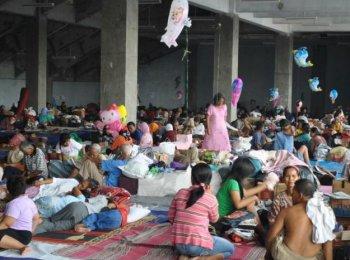YOGYAKARTA, Indonesia—While the imminent danger of Indonesia’s Mount Merapi volcano has subsided, new hardships face the thousands of refugees left in the ashes of the eruption. Even many whose homes were not destroyed are unable to return, as they reside within the designated danger zone.
To tell their story, I spent a night with the refugees at the Maguo Harjo Stadium, in Sleman, Yogyakarta, on Nov. 15.
The stadium now holds about 9,000 refugees, down from the tens of thousands residing there just days ago. Many evacuees returned home, some moved to refugee camps closer to their villages, while others went to stay in the homes of relatives.
Tents provided by volunteers and humanitarian organizations go nearly unused, as the refugees prefer to stay in the stadium building. With three floors, the stadium is able to hold most of them, and the first floor—which seems to be the local favorite—holds the bulk.
Mats and blankets are the beds of choice, although others have taken to sleeping on simple cloths. Many youth, who aren’t used to sleeping on the floor, have taken piles of donated clothing as their beds.
There is a mix of grief and relief among the crowd, with hints of both joy and sorrow. Some people stay awake until midnight, occupying themselves by watching television.
Mutirah, 32, a mother of two was among the sleepless. “We started to evacuate to here on Friday [Nov. 5]; the four of us with my husband and children,” Mutirah said, who lived in Umbulharjo Village, Sleman regency.
Mutirah said she and her family have had no problem with food since coming to the camp, as its “always available,” and noodles and snacks are readily provided.
Despite the small comforts, however, she hopes her stay there won’t be long. After spending 10 days in the crowded camp, she’s suffered “mumet” (stress), headaches, and fatigue.
For the children the situation is more bearable. Nana, a 16-year-old high school student, said her school was in the safe zone and is still running as usual, but since her home is in the danger zone, she and her parents have stayed at the camp.
She said she enjoyed herself as there are “a lot of friends,” but the “sorrows are not comfortable.”
When it comes to food, Nana said she and her family get tickets for meals, but they “just grab breakfast and dinner” and stick to snacks in the afternoon.
After learning of the hardships of the refugees, I slept on the floor with the rest, sharing in their stories, and their waiting.
Overnight With Merapi Refugees, in the Volcano’s Aftermath
Mount Merapi volcano has subsided, new hardships for thousands of refugees left in the designated danger zone.
WAITING IT OUT: Refugees from Indonesia's Mount Merapi volcanic eruption sleep in close quarters at Maguo Harjo Stadium, in Sleman, Yogyakarta, on Nov. 15. Wayan Manuh/The Epoch Times
|Updated:

